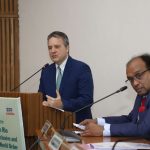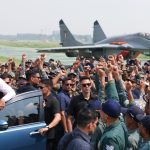 Since President Rouhani’s election, Iran has made considerable effort towards ‘constructive engagement’ with the Gulf Cooperation Council. Foreign Minister Javad Zarif visited Qatar, Kuwait, Oman and the UAE soon after his appointment. President Rouhani also visited Oman and signed an agreement to build a gas pipeline across the Gulf. Despite Rouhani’s calls for improvement in Riyadh-Tehran relations, Saudi Arabia – followed by Bahrain – has resisted Iran’s diplomatic overtures until now. However, Riyadh recently extended an invitation to Tehran’s Foreign Minister Mohammed Javad Zarif, indicating towards a possible thaw in relations. In this scenario, let us examine the scope of Saudi-Iran relations and US attempts to balance the regional security architecture against a US-Iran nuclear detente.
Since President Rouhani’s election, Iran has made considerable effort towards ‘constructive engagement’ with the Gulf Cooperation Council. Foreign Minister Javad Zarif visited Qatar, Kuwait, Oman and the UAE soon after his appointment. President Rouhani also visited Oman and signed an agreement to build a gas pipeline across the Gulf. Despite Rouhani’s calls for improvement in Riyadh-Tehran relations, Saudi Arabia – followed by Bahrain – has resisted Iran’s diplomatic overtures until now. However, Riyadh recently extended an invitation to Tehran’s Foreign Minister Mohammed Javad Zarif, indicating towards a possible thaw in relations. In this scenario, let us examine the scope of Saudi-Iran relations and US attempts to balance the regional security architecture against a US-Iran nuclear detente.
On May 13, 2014, Saudi Foreign Minister Prince Saud Al Faisal announced Riyadh’s readiness to negotiate with Iran and resolve differences between the two Gulf States. He said that “anytime (Zarif) sees fit to come, we are willing to receive him”1. Iran welcomed the development stating that while no written invitation had been received, “a plan for the two ministers to meet is on the agenda”2.
This declaration came just short of another round of nuclear negotiations between Iran and P5 +1 in Vienna. Saudi Arabia’s announcement coincided with US Defence Secretary Chuck Hagel’s visit to Riyadh for the US-GCC Strategic Defence Dialogue. Hagel stressed on US-GCC and intra-GCC military cooperation in order to counter Iran’s “destabilising activities” and its efforts to undermine GCC stability3. At the Manama Dialogue in December last year, he had stated that the nuclear deal with Iran does not mean that “the threat from Iran is over”4.
US Secretary of State, John Kerry welcomed this development and said that the US had nothing to do with the invitation. He stated that the US was pleased to see Saudi Arabia engaged in diplomacy even though there is “longstanding difficulty in that relationship” (with Iran). “We hope that it might be able to produce something with respect to one of the several conflicts in which the Iranians could have an impact”5.
The United States is making considerable efforts to reassure the Gulf States, particularly Saudi Arabia, of its commitment to the security of the region. As they have pursued nuclear negotiations with Iran, the US has maintained that the “military option is on the table” if the diplomatic route is unsuccessful. At the Manama Dialogue, Hagel listed US military assets in the region and stated that the US has sought to “shift the military balance of the region away from Iran and in favour of our Gulf partners”. Even now the emphasis will be on building their military capabilities, not just through bilateral relationships with the US but also through stronger integration within the GCC.
The US attempted to mitigate the differences within the GCC through the US-GCC Strategic Cooperation Forum (SCF) launched in March 2012. This framework aims to enhance “coordination of policies which advance shared political, military, security and economic objectives” and “deepen the close relations between the two sides”. The third communiqué of SCF reiterates commitments towards US-GCC coordination on an integrated Ballistic Missile Defence system and improving GCC unity in defence planning and procurement of weapons and technology6.
Ten days after the Manama Dialogue, President Barack Obama issued a directive selling weapons to the GCC states — mainly missile defence systems under the Foreign Assistance Act of 1961 and the Arms Export Control Act. The US, therefore, dealt with the GCC States as a bloc for the first time, instead of selling weapons systems to individual nations within the council7. In March 2014, President Obama visited Riyadh to assuage fears of US retrenchment from the region.
Prince Turki Al Faisal, former Saudi intelligence chief responded to these developments stating that they indicate “support for Saudi Arabia’s plan for a unified GCC”8. Riyadh’s call for greater GCC integration, however, has not been supported by some member states. Oman rejected the proposal saying it would withdraw from the GCC if the council proceeded with it.
The long-standing animosity between Saudi Arabia and Iran has stemmed political and ideological differences, as well as a quest for regional hegemony. While the 1979 revolution in Iran installed an anti-American theocracy in Tehran, Riyadh has sought to balance Iran’s regional ambitions through an American-led security framework in the region. Saudi Arabia and Iran are engaged in ‘proxy-wars’ in Syria, Lebanon, Yemen and Iraq.
Saudi Arabia’s regional policy is driven by its goal of regime security. On the domestic front, Riyadh faces a threat to its political stability from ideological influences and movements. Iran’s Islamic revolution was symbolic of the possibility of political change and the Ayatollah condemned monarchies as “contrary to Islam”9. Thus, Saudi Arabia fears Iran’s ability to export the revolution to its borders, particularly by inciting the Saudi Shia community.
As Iran’s influence spread with the fall of Saddam Hussain in Iraq, Hezbollah’s victories in Lebanon and President Assad’s resilience in Syria, Riyadh made efforts to counter the rise in Iranian power by supporting opposing factions in these countries. These conflicts have given the Saudi-Iranian rivalry an increasingly sectarian character.
The fall of Saddam Hussein was considered a turning point for Shia-Sunni conflict in the region. This period, termed as the “Shia Revival”10, mobilised Shia communities in Saudi Arabia, Lebanon and Bahrain and led to the creation of “transnational networks” of mosques and clerics that tie the communities to those in Iraq and Iran. Tehran hosted Iraqi Prime Minister Nouri Al-Maliki while in exile and the IRGC trained and equipped militias of Iraqi Shiite parties11.
Syria too is a ground for geopolitical and sectarian rivalry between Riyadh and Tehran. Iran and Syria are allies since the 1979 Revolution and Tehran has provided military and financial assistance to Shia Alawite President Assad’s regime. Riyadh has supported the fractured Sunni rebel factions in an effort to install a friendly regime in Damascus. They also looked to the Obama administration to take military action against President Assad. Washington’s reluctance to take military action and the failure of the Geneva II12 talks on Syria have resulted in a deadlock.
Therefore, tensions between Saudi Arabia and Iran continue to persist over regional ambitions and ideological differences. Riyadh may be compelled to improve relations with Iran due to a shift in US-Iran relations and the positive reception of Iran’s overtures by the other GCC States. It is, however, balancing against Iran through a conventional weapons build-up, efforts towards a GCC Union and geostrategic competition with Tehran. The US has attempted to mitigate Saudi fears by bolstering greater military integration within the GCC. A thaw in Saudi-Iran relations remains unlikely unless both states de-escalate their involvement in the Levant.
Courtesy: ORF
1 “Saudi Arabia reveals invitation to Iranian FM”, Al Jazeera, 14 May, 2014 http://www.aljazeera.com/news/middleeast/2014/05/saudi-arabia-reveals-invitation-iranian-fm-20145144401119259.html
2 Arash Karami, “Iran Foreign Ministry welcomes Saudi overture”, Al-Monitor, 14 May, 2014
http://www.al-monitor.com/pulse/originals/2014/05/saudi-foreign-minister-invites-iran-visit.html
3 Chuck Hagel, Remarks to the Press at US-GCC Defence Dialogue, US Department of Defence, 14 May, 2014
http://www.defense.gov/Speeches/Speech.aspx?SpeechID=1848
4 “Chuck Hagel reassures Gulf Nations Iran deal will not stop flow of US arms, The Guardian, 7 December, 2013
http://www.theguardian.com/world/2013/dec/07/chuck-hagel-gulf-iran-deal-weapons
5 John Kerry, Remarks with Italian Foreign Minister Federica Mogherini after their meeting, US Department of State, 13 May, 2014
http://www.state.gov/secretary/remarks/2014/05/226060.htm
6 Joint Communiqué from the third ministerial meeting for the US-GCC Strategic Cooperation Forum, US Department of State, September 26, 2013
http://www.state.gov/r/pa/prs/ps/2013/09/214834.htm
7 For more information on US defence posture in the Gulf, see Kenneth Katzman, “Iran: US Concerns and Policy Responses”, Congressional Research Service, March 5, 2014
8 Zachary Fryer-Biggs and Awad Mustafa “Obama Issues directive to sell weapons to GCC”, Defense News, December 18, 2013
http://www.defensenews.com/article/M5/20131218/DEFREG04/312180019/Obama-Issues-Directive-Sell-Weapons-GCC
9 F. Gregory Gause III, “Saudi Arabia’s Regional Security Strategy”, in “International Politics of the Persian Gulf”, Syracuse University Press, New York 2011
10 For more on Iraq-Iran relations see Vali Nasr, “When the Shiites Rise”, Foreign Affairs, July/August 2006 http://www.foreignaffairs.com/articles/61733/vali-nasr/when-the-shiites-rise
11 Ibid
12 The Geneva II conference was held on January 22, 2014 to find a political solution to the crisis in Syria
Author Profile
- India Writes Network (www.indiawrites.org) is an emerging think tank and a media-publishing company focused on international affairs & the India Story. Centre for Global India Insights is the research arm of India Writes Network. To subscribe to India and the World, write to editor@indiawrites.org. A venture of TGII Media Private Limited, a leading media, publishing and consultancy company, IWN has carved a niche for balanced and exhaustive reporting and analysis of international affairs. Eminent personalities, politicians, diplomats, authors, strategy gurus and news-makers have contributed to India Writes Network, as also “India and the World,” a magazine focused on global affairs.
Latest entries
 India and the WorldJuly 7, 2025BRICS boost for India, Modi calls out double standards on terror
India and the WorldJuly 7, 2025BRICS boost for India, Modi calls out double standards on terror India and the WorldJuly 6, 2025Expanded BRICS will play key role in global governance reforms: Brazil’s Envoy
India and the WorldJuly 6, 2025Expanded BRICS will play key role in global governance reforms: Brazil’s Envoy India and the WorldJune 26, 2025Operation Sindoor: India Sheds Restraint, Rediscovers Utility of Force
India and the WorldJune 26, 2025Operation Sindoor: India Sheds Restraint, Rediscovers Utility of Force India and the WorldJune 23, 2025BRICS summit in Rio to focus on Global South, local currency trade
India and the WorldJune 23, 2025BRICS summit in Rio to focus on Global South, local currency trade







